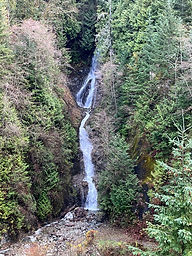Battling Alien Invaders
- kc dyer

- Aug 29
- 3 min read
Updated: Sep 2
Supporting the growth of Indigenous plants

Signs have been popping up around Village streets over the summer, notifying residents of treatment taking place to eradicate invasive plant species.
The signs are placed by the Sea to Sky Invasive Species Council (SSISC), which has made a long-term commitment in this region to support the growth of indigenous species.
SSISC Co-Executive Director Claude-Anne Godbout-Gauthier, says that a number of plant species are of concern in this area. These include Spurge laurel, a variety of Knotweed species and Giant Hogweed, which Godbout-Gauthier calls the "poster child" of invasive species in the region.
Giant hogweed is extremely tall (two to five metres), with large, deeply incised leaves and wide, umbrella-like flower clusters. Its' sap is toxic, causing severe burns and blistering as it sensitizes skin to UV radiation.
Godbout-Gauthier says the plant is not only dangerous to humans, but also to the ecosystem, as infestations of the shallow-rooted plant can result in increased erosion.
Spurge laurel is also deadly poison; as few as two to three berries can prove fatal if ingested by children. She notes that all parts of this plant are highly toxic and can cause harm to humans and other animals through skin contact, ingesting any part of the plant or breathing in sap droplets when removing plants.
Since this plant can be found throughout the Village, Godbout-Gauthier says the SSISC team has been focusing their eradication efforts in high-use areas, such as parks and around the school.
As for the knotweed, all the varieties are speedy propagators that can cause serious erosion, threaten biodiversity and disrupt food chains by reducing available habitat. Japanese knotweed is considered invasive world-wide.
The SSISC also recommends that a number of invasive plants be kept out of Lions Bay gardens if at all possible, including English ivy, periwinkle and yellow lamium.
In addition to the Spurge laurel and Giant Hogweed, the SSISC have been treating Village roadsides for a broad-leaved peavine. The concern is that flat pea and broad-leaved peavine can grow in dense patches, outcompeting native trees and shrubs.
Heading into the fall season, the SSISC has a few recommendations for local gardeners to control invasive species:
Watch out for seeds: many invasive plants have likely already gone to seed. Disturbing the plants by raking or pulling them up risks spreading the seeds. To avoid this, it’s best to identify and research the plants before getting started with fall clean-up. You can do that HERE.
Compost invasive plants separately: Since Lions Bay is a part of Metro Vancouver's large-scale composting program, Lions Bay residents can take their invasive plant waste to the North Shore Recycling and Waste Centre for industrial composting. Read more about the program HERE.
Stay informed: Follow @ssinvasives on social media, or subscribe to the SSISC newsletter HERE.
Godbout-Gauthier says it's everyone’s responsibility to help control invasive species, and suggests that small actions can make a difference:
Learn how to identify the plant and animal species around you: iNaturalist is a wonderful app to get started.
Help spread the word: Talk to your neighbours and friends about the invasive species you are noticing in your area. Many hands make light work!
You can do your part to prevent the spread of invasives even as you are enjoying the outdoors. Play Clean Go for hikers and campers, Be Plantwise for gardeners, and Clean Drain Dry for boaters each offer hints to ensure invasive plants are not encouraged.
Find out more about common invasive species found on residential properties HERE .
Click HERE for more about the species that SSISC controls in Lions Bay.
Editor's note: The Watershed contacted a representative of Metro Vancouver Waste Disposal on September 2 for clarification on the disposal of toxic plant material including Giant Hogweed, Knotweed and Spurge. The representative recommended that residents hire a knowledgeable landscaper to remove these toxic plants, in order to minimize the danger to both the homeowner and the garbage disposal personnel. She said that if the resident is determined to do the work themselves, the material must be double-bagged and left in the garbage section of the North Vancouver Transfer station, where it will either be buried or transferred to the Burnaby location and incinerated.

The Watershed values your opinion. Leave your thoughts below or
Like what you're reading?
For as little as $5/month, you can support local independent journalism








I have also had difficulty deciphering the information about where to get rid of invasive plants. It is a complex issue and it would be great if there could be more clarity provided by the waste disposal experts on the north shore. I believe people will be more likely to try to eliminate invasive plants if there is a relatively straight forward way to dispose of them. Thanks for the excellent article and for highlighting this important issue.
karen, thanks for including the Metro Vancouver disposal options document. This provides a lot of useful information in one place. I've had a hard time making sense of all the options in the past. However, my reading of this document it seems that not all invasive plants can actually be taken to the north shore recycling depot, contrary to this post.
The two invasive plants of significance highlighted in the article, giant knotweed and spurge laurel, are described as toxic plants in the metro vancouver document. These are to be double-bagged, a waste assessment form completed, and taken to the Delta depot, and to not the north shore depot.
All other invasive plants (I'm assuming English ivy, Himalayan blackberry, etc.)…